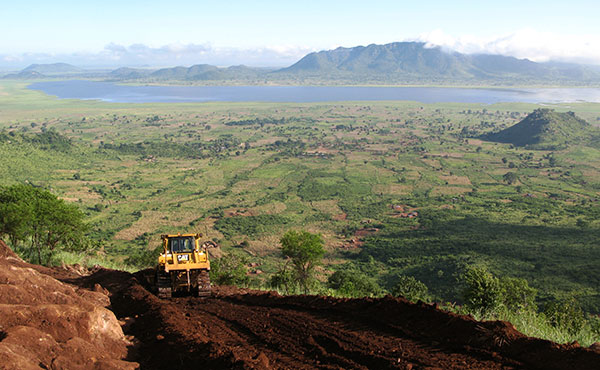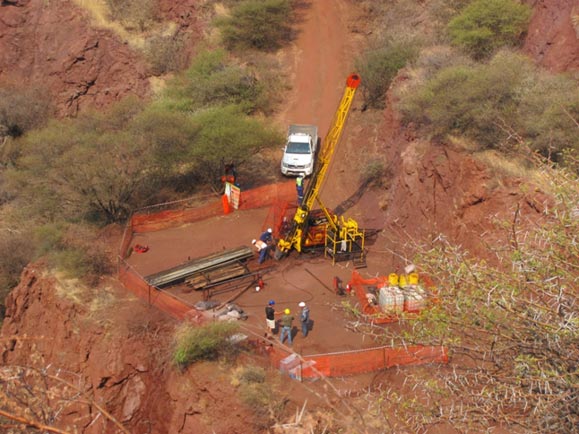Natural laboratories
For the HiTech AlkCarb project we have chosen a set of 'natural laboratories' where we will focus our research work. These areas show many of the key features of alkaline complexes and carbonatites.
Kaiserstuhl, Germany
Kaiserstuhl is an alkaline-carbonatite volcano in the hills of Baden-Württemberg in south-west Germany that was mined for niobium (Nb) in the 1950s, and showcases many key features of extrusive and intrusive igneous rocks within a rift valley. The volcano last erupted about 18 million years ago. The site has previously been well mapped and studied, including geochemical mapping, three drill holes for petrological investigations down to 400 m, and a 1 km-spaced airborne magnetic survey.
In addition to the carbonatite formerly mined for Nb, there is an REE-rich dolomite carbonatite dyke, and an active phonolite quarry.
The site is well-known and easily accessible, and will be a major research test site for HiTech AlkCarb. We plan to carry out new, detailed airborne and ground-based geophysical surveys and link these with core analysis and downhole geophysics from a new research drill hole, in order to develop a 3D understanding of this alkaline-carbonatite system.
Roman region, Italy
The Polino carbonatite in central Italy is an unusual occurrence with an interesting history, stretching back to 1760 when Pope Clemente XIII received a metallic medallion from this "gold mine". Two hundred years later it was recognised as a carbonatite diatreme, and the Roman region has recently been identified as the largest field of REE phosphate-rich fluoride and carbonatite extrusives in southern Europe.
Further south, the unaltered, high temperature carbonatites from Monte Vulture in the Italian Apennines are attractive for their REE potential. The Italian carbonatites will be used as a natural laboratory to develop predictive tools for mineralisation at depth in alkaline volcanic areas.
Southern Greenland
Greenland is endowed with several significant REE deposits hosted in various geological settings. The largest of these is the highly peralkaline Ilímaussaq intrusion of the Mesoproterozoic Gardar province in the south, which hosts two advanced REE projects, Kringlerne and Kvanefjeld.
Numerous other potential REE deposits are known in both alkaline rocks and carbonatites in south and west Greenland, and these represent an excellent opportunity to study the deeply eroded parts of these systems.
We will study volatile elements in the roof zones of the Greenland alkaline complexes, in order to improve our understanding of how the mineralisation forms and to predict what may be found at depth. A wealth of geological data from Greenland, including data from project partner GEUS, can be found in the Greenland Mineral Resources Portal.
Chilwa alkaline province, Malawi
The large intrusions of the Chilwa alkaline province in southern Malawi are classic areas of carbonatite and alkaline magmatism. The Mulanje Massif covers some 640 km2 and rises to a height of over 3000 m, whilst the Michese intrusion has an 8 km diameter with numerous smaller plugs and dykes nearby. The intrusive centres date from the early Cretaceous and are remarkable for their diverse rock types including granites, quartz syenites, trachytes, phonolites, ijolites and fenites.
The Songwe Hill REE deposit is the subject of an advanced project led by project partner Lancaster (Mkango Resources Ltd), who have done extensive sampling and drilling to establish an indicated resource of 13.2 million tonnes (1.62 per cent total rare earth oxides (TREO)) and an inferred resource of 18.6 million tonnes (1.38 per cent TREO). It represents an analogue for the shallow depth intrusions below European occurrences such as Kaiserstuhl.
The Malawi natural laboratory will provide information for many of the key research questions in HiTech AlkCarb, especially the potential use of fenite zones as exploration indicators.
Namibia
There are more than 50 occurrences of carbonatites and alkaline rocks across four age groups in Namibia, and various erosion levels. These include the heavy REE carbonatite deposit at Lofdal, the Okorusu fluorspar mine, and several localities with active exploration licences for REE, tantalum, and niobium.
Project partners Geoafrica will provide experience in Namibia as well as knowledge of the best practice use of hyperspectral imaging, field mapping, radiometrics, and drilling.
The Namibian field sites will be used to study the potential for fenites and hydrothermal systems as exploration indicators.
Mongolia
The southern Mongolian alkaline province is well known for very high-grade REE deposits associated with alkaline-carbonatite volcano-plutonic complexes. The range of rock types, erosion levels, mineralisation styles and depths of drilling make it an outstanding exploration analogue for comparison to European deposits. The complexes are controlled by east–west faults formed in a continental rift environment, although other explanations have been proposed.
The Lugiin Gol REE deposit has detailed 3D maps, created from drilling down to depths of 1000 m. Other deposits include Bayan Khushu and Mushgai Khudag with REE phosphates, barite-celestine and REE-enriched fluorcarbonates at depths up to 300 m.
This natural laboratory will allow us to investigate the plumbing systems and mineralisation in shallow intrusions.
South Africa
In the Limpopo province, the Glenover carbonatite complex is unusual for its enrichment of scandium, which we will study in the HiTech AlkCarb project. Historically mined for phosphate by Goldfields, this 8 km wide carbonatite has been dated as 1000 million years old and the long-term weathering has resulted in a residual, secondary REE-enriched apatite-haematite breccia. A 10 million tonne resource has been identified and metallurgical work is currently underway.
Besides the residual breccia ore, carbonatites and pyroxenites also contain significant amounts of REE, phosphate, niobium and scandium.








